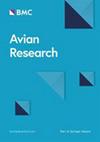亚高山林莺复合体的物种状态和遗传隔离:来自线粒体DNA分析的见解
IF 1.7
2区 生物学
Q1 ORNITHOLOGY
引用次数: 0
摘要
本研究利用线粒体DNA (mtDNA)分析了亚高山林莺(Curruca cantillans)复合体的遗传分化和基因流动。根据系统发育发现和地理分布,我们重点研究了三个主要种群。Pop1:包括C. C. albistriata(分布在意大利东北部(的里雅斯特),斯洛文尼亚南部,沿亚得里亚海北部海岸向南至阿尔巴尼亚,以及东至保加利亚南部,希腊,克里特岛和土耳其西部,在马里东部到苏丹西北部的萨赫勒中部和东部有非繁殖地)和C. C. cantillans(出现在西西里岛,意大利中部和南部,以及意大利中北部的局部地区,可能在萨赫勒西部有非繁殖地)。Pop2:代表在西班牙和法国西部发现的伊比利亚c。Pop3:包括亚高山C.,分布在巴利阿里群岛、科西嘉岛、撒丁岛、一些托斯卡纳岛屿以及意大利北部和中部,非繁殖地延伸到萨赫勒西部,到达尼日利亚北部和尼日尔。我们的遗传分析表明,这三个种群最近都有扩张,但保持着独特的遗传结构。尽管最近有这种扩张,但种群表现出有限的遗传多样性。使用AMOVA,我们发现大多数遗传变异是在群体之间而不是群体内部,表明显著的遗传分化。这项研究将种群遗传数据与先进的分析相结合,提供了亚高山莺群遗传结构和连通性的详细见解,突出了地中海生物多样性热点地区独特的遗传谱系。本文章由计算机程序翻译,如有差异,请以英文原文为准。
Species status and genetic isolation in the Subalpine Warbler complex: Insights from mitochondrial DNA analysis
This study investigates the genetic differentiation and gene flow within the Subalpine Warbler (Curruca cantillans) complex using mitochondrial DNA (mtDNA) analysis. We focused on three primary populations based on phylogenetic findings and geographical distributions. Pop1: Includes C. c. albistriata (distributed in extreme northeast Italy (Trieste), southern Slovenia, and south along the north Adriatic coast to Albania, as well as east to southern Bulgaria, Greece, Crete, and western Turkey, with non-breeding grounds in the central and eastern Sahel from eastern Mali to northwest Sudan) and C. c. cantillans (occurring in Sicily, central and southern Italy, and locally in north-central Italy, with non-breeding grounds presumably in the western Sahel). Pop2: Represents C. iberiae, found in Spain and western France. Pop3: Comprises C. subalpina, distributed across the Balearic Islands, Corsica, Sardinia, some Tuscan islands, and north and central Italy, with non-breeding grounds extending into the western Sahel, reaching northern Nigeria and Niger. Our genetic analysis indicates that all three populations have expanded recently but maintain unique genetic structures. Despite this recent expansion, the populations exhibit limited genetic diversity. Using AMOVA, we found that most genetic variation is between populations rather than within them, indicating significant genetic differentiation. This study uniquely combines population genetic data with advanced analyses to provide detailed insights into the genetic structure and connectivity of the Subalpine Warbler complex, highlighting the distinct genetic lineages within the Mediterranean biodiversity hotspot.
求助全文
通过发布文献求助,成功后即可免费获取论文全文。
去求助
来源期刊

Avian Research
ORNITHOLOGY-
CiteScore
2.90
自引率
16.70%
发文量
456
审稿时长
46 days
期刊介绍:
Avian Research is an open access, peer-reviewed journal publishing high quality research and review articles on all aspects of ornithology from all over the world. It aims to report the latest and most significant progress in ornithology and to encourage exchange of ideas among international ornithologists. As an open access journal, Avian Research provides a unique opportunity to publish high quality contents that will be internationally accessible to any reader at no cost.
 求助内容:
求助内容: 应助结果提醒方式:
应助结果提醒方式:


